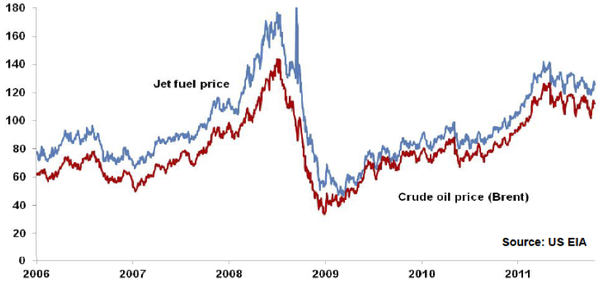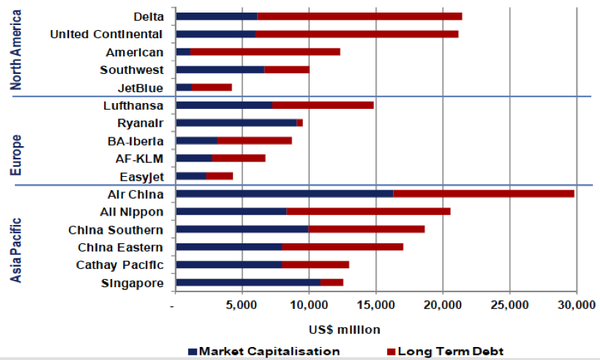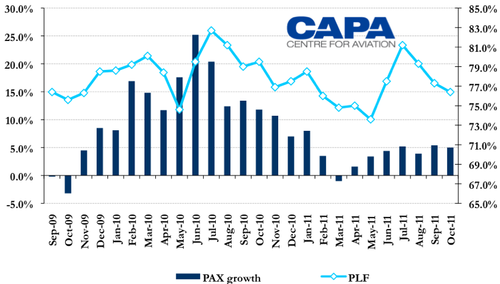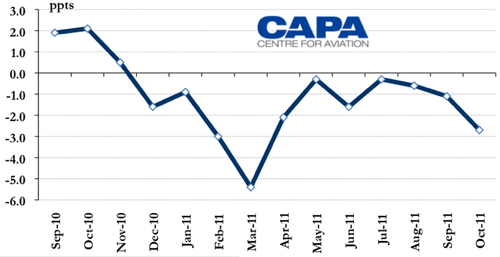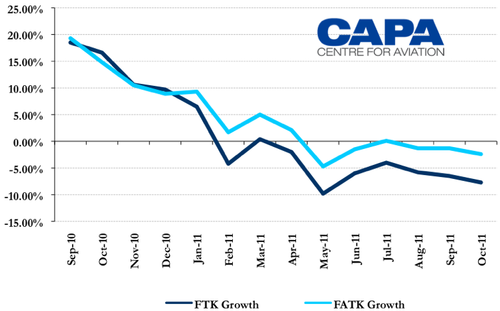Asian airline margins being squeezed but are faring better than in other regions: AAPA
Airline margins have been "squeezed" in 2011, due to sharply higher fuel prices, according to the Association of Asia Pacific Airlines (AAPA), although the association noted that the region's airlines are faring better than airlines in other regions as they continue to benefit from relatively strong economic growth in developing economies across the region.
AAPA, at the 55th Assembly of Presidents in Seoul earlier this month, stated its member carriers remain "extremely vigilant" about the immediate threats to growth and profitability associated with a potential slowdown in the global economy and fuel prices that have already risen 40% this year. The association also cautioned that while strong domestic spending is ensuring key Asian economies remain resilient, there is increasing concern about the possible impact of further financial instability in Europe and the US moving into 2012.
- Airline margins have been squeezed in 2011 due to higher fuel prices, but Asia Pacific airlines are faring better than airlines in other regions.
- The traditional distinctions between full-service network carriers and low-cost carriers are becoming blurred in the Asia Pacific region.
- Asia Pacific aviation represents a quarter of global passenger traffic and 42% of global air cargo traffic.
- Passenger traffic continues to grow, but international air freight markets are weakening.
- Asian carriers are grappling with new taxes and regulations, including the European Union's Emissions Trading Scheme.
- Despite challenges, the overall outlook for Asian carriers is relatively positive, with growth expected to outpace mature markets.
Jet fuel and crude oil price (USD/barrel): 2006 to 2011
Structural changes occurring in Asia Pacific with LCC-network carriers distinctions being blurred
AAPA director general Andrew Herdman has also noted the structural changes occurring in the region. "The traditional distinctions between full service network carriers, and low cost carriers focusing solely on short haul point to point routes, have become increasingly blurred over time. The recent development of a number of new joint-ventures between traditional carriers and new entrants, seeking to combine their respective strengths and tap new markets is testimony to this trend," he said upon the release of the association's Oct-2011 traffic on 24-Nov-2011.
Asia Pacific aviation represents a quarter of global passenger traffic and 42% of cargo traffic
According to AAPA, Asia Pacific aviation now represents a quarter of global passenger traffic and 42% of global air cargo traffic. Asia Pacific aviation handles 521 million annual passengers, comprised of 433 million domestic and 188 million international travellers, and 18 million tonnes of freight, generating revenues of USD144 billion.
The scope for further growth is considerable, with the region now generating 27% of global GDP and being home to more than 4 billion people, or 62% of the world's population. Operations are supported by a growing fleet of 4390 aircraft. AAPA forecasts global air travel demand to double over the next 15 years, led by growth in the Asia Pacific.
Mr Herdman also noted that leading Asian carriers have the highest market capitalisations in the global industry. As a result, if ownership regulations are liberalised, global consolidation is more likely to be led by Asian carriers as European or US carriers would lack the cash needed to pursue acquisitions in Asia. "It is money that talks," Mr Herdman said. "Think about that if we do get further liberalisation of control. Certainly Asian carriers will be even more important in terms of players on the global stage."
See related article: Asian aviation outlook relatively positive despite continued weakness in Japanese inbound market
Airline enterprise values by region
Sustained growth in passenger traffic; freight markets continue to soften
AAPA preliminary figures for Oct-2011 showed a continuation of the established trend of growth in international air passenger traffic and continued weakness in international air freight markets.
AAPA international scheduled traffic: Oct-2011 vs Oct-2010
AAPA members handled 16.5 million international passengers in Oct-2011, a 5.0% year-on-year increase. Passenger numbers have increased in all but one month (Mar-2011) of 2011 and in every month of 2010. Mr Herdman said the region's carriers have continued to see growth in demand for both business and leisure travel.
AAPA passenger numbers growth and passenger load factor: Sep-2009 to Oct-2011
International traffic (RPKs) increased 5.1%, outpaced by an 8.8% capacity (ASKs) expansion as a result of additional aircraft deliveries and resulting in a 2.7 ppt reduction in load factors to 76.4%. International capacity growth at Asia Pacific airlines has exceeded traffic growth for the past 11 months. As a result, load factors have also declined for the past 11 months (Dec-2010 through Oct-2011) after 16 consecutive months of year-on-year gains between Aug-2009 and Nov-2010.
AAPA RPK growth and ASK growth: Sep-2010 to Oct-2011
AAPA PLF growth: Sep-2010 to Oct-2011
Cargo declines continue
International air cargo markets showed further weakness in Oct-2011, with the region's carriers feeling the impact of slowing Asian exports as a result of slower economic growth seen in Europe and North America.
Asia Pacific international air cargo demand (FTKs) declined by 7.7% year-on-year in Sep-2011, for the seventh consecutive month of year-on-year declines. Cargo capacity was reduced by a lesser decrease (-2.4%) resulting in a 3.9 ppt decline in the average international air cargo load factor for the region's carriers to 66.8%.
AAPA FTK growth and FATK growth: Sep-2010 to Oct-2011
Aviation grappling with new taxes and rules: AAPA
Mr Herdmann, meanwhile, stated that while aviation will play a key role in global economic recovery, it is struggling with the impact of new taxes and regulations. Governments should remember "that aviation is a key contributor to economic recovery and job creation, led by travel and tourism", he said at the Assembly of Presidents. "Taxing the very people who you want to attract as visitors to your country is neither an effective welcome message nor a good way to develop the tourism industry," he added.
He also lamented that airlines are increasingly subject to "an ever more complex web" of regulatory requirements. A key part of this is the European Union's controversial EU Emissions Trading Scheme (ETS) scheme, which AAPA believes is an over-reach in the authority of the EU.
See related article: EU ETS dominates agenda at November airline meetings, starting with Assoc of Asia Pacific Airlines
Asian aviation outlook relatively positive
Asian carriers continue to be impacted by weakness in the inbound Japanese leisure market as the recovery from the Mar-2011 earthquake and tsunami has been much slower than initially projected. However, the overall outlook for Asian carriers is relatively positive as growth in Asia is expected to continue outpacing growth in mature markets, particularly Europe, by a wide margin.
